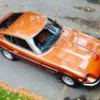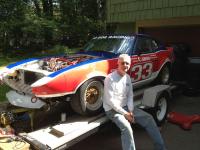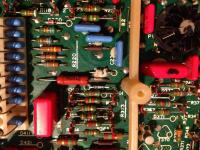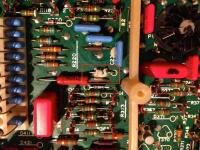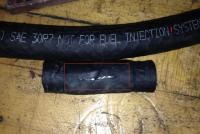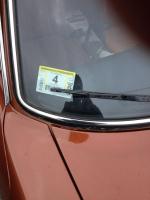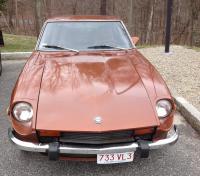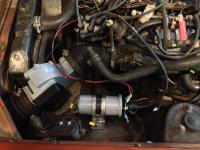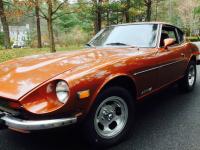Everything posted by sscanf
-
A trip to the air port
While I work on making it as reliable as I can my next question: Is AAA better than the towing coverage from my regular insurance company? How far will they tow it if I break down? Sorry to go off topic but... I do take some strange sort of pride in that none of my fleet of crap cars has never been towed (we have five, only one is less than 10 years old). Last year the alternator died in my 1999 Accord when I was some distance from home. I kind of knew it was going so had a portable jumper unit with me. I managed to get it most of the way home by running it with the jumper unit attached to the battery while I was driving (plenty of room under the hood on that car). To get it the last 10 miles I charged the battery from another car using jumper cables (no, I did not drive with the jumper cables attached to another car . I just let it charge for 10 mins or so). I learned on this car that you must be resourceful if you drive a car with "personality": Anyone here recognize it? That photo was taken around 1982 but it was an old car then - I loved that car and would love to have it again - but it didn't really love me back.
-
A trip to the air port
Thanks for all of the suggestions. The WLK-24236 additional muffler is on my list now, along with all new rubber seals all around (it also stinks in the cabin when the windows are open), sealing up holes (PO removed A/C - I'm pretty sure that left some holes in the firewall), and adding some heat/sound insulation. Probably the headlight relay is on my list too. I also plan on replacing all of the EFI connectors and checking the wiring. I know the temp sensor wires were looking stressed when I was working on the temp sensor mod. Probably most of the wires under the hood could use replacing. I have since taken it out on two other longer trips without any major hiccups. I have a load of tools and parts and duct tape with me though, just in case.
-
Bad Dog!
Like many of you, I purchased a Bad Dog frame rail kit for my Z (they are made slightly over-sized so that they can fit over the old , holey - but cleaned up - frame rails). Unlike many of you, John Jeffery (Bad Dog) lives so close that he dropped them off. I did most of the work on my 280 myself but I did pay to have these welded in and have it gone over by my guy. These surely saved me lots of money and materials cost. My welder said that they worked out great and were made from nice heavy material. Anyway, while John was over he told me all of the parts he could help me out with so I contacted him a couple of weeks ago about finding a 240Z bumper, an uncracked 280Z center console, and a 240Z steering wheel. Well, he came through with all three (and he gave me the bumper because of a couple of imperfections). He also gave me a really nice deal on the beautiful steering wheel and the console. While I was there, I got a chance to see his teams 240Z race car (and his 240Z street car - each a site to behold) and chat about Z's and racing. John is a really nice guy and knows his stuff and his team's 240 race car is quite something to see. He was getting ready for some upcoming races and teaching. While I was there I snapped a photo, and I thought you all might like to see it:
-
A trip to the air port
Hi All, I haven't ventured much away from the Fuel Injection board so this is a foray out into the broader site for me... Background I have 1976 280Z that I have been working on slowly for a couple of years. I bought it in 2012 for $1200 but came to me in pieces. The body and frame were pretty clean though for these parts (I am in Mass but the car grew up in CA). Yesterday was the first time I took it out on the highway and ventured further than 10 miles from home. It was a little bit more of an adventure than I hoped for but, all in all, it turned out just fine... Besides the work on the EFI system which is detailed elsewhere (mostly all new/rebuilt including injectors and a ZX distributor/ignition module, fuel hose , I put in an MSA header and performance exhaust, the brakes are all done (new calipers, pads, master cylinder, drums, one rear cylinder, pads, shoes, the front disks looked nearly new so I left them alone). New clutch (OEM Exidy) and slave cylinder. New wheels and tires. I had to repair or replace lots and lots and lots of little things (dome light, windshield washer lines and motor - fixed by smacking it hard with a screw-driver handle and running it backwards, a bad hatch strut, the list goes on and on). BadDog frame rails. Probably a familiar list to many of you. I finally got it on the road a couple of months ago. Anyway, it has been a daily driver for me for a couple of months but mostly just for my short commute to work (8 miles of back roads). Yesterday I had to pick my son up from the airport (Manchester, NH, not Boston) in the middle of the day so I figured it would be a good test to see how it goes on the highway. It was an interesting trip. How It Went First of all, in the end, it all went well and the car performed very well. I had some fun on the on-ramps and hit it pretty hard once or twice all the way up to 5000RPMs. I had no problems and at 70+ MPH except for some wheel bounce (I bought the "new to me" wheels and tires on Craig's List). I need to get them balanced. It was a hot day and I had the windows wide open the whole way - much more fun than A/C. Temp Gauge My temperature gauge is not working and this is something I don't like, especially since this was its first time running at over 3000 RPMs for a while but I had no problems there either. The cooling system is in good shape and the coolant reservoir has been maintaining its level. Steering I did have some problems though. One nagging problem is that when the steering wheel is at dead center, there is a very tiny bit of play. I need to figure that one out. When I got it inspected, the guy gave me a sticker but he told me to check the front wheel bearings because they felt loose to him and he was right. I had to tighten both sides but I have a feeling that, if I were to check them again, they will be off specs again. I think this is the problem and I hear there is a procedure for getting the front wheel bearings properly torqued (I think they were replaced along with the front disks by the PO). Maybe I will just replace them. Throttle Linkage As I approached the first rotary at the air port, I completely lost my accelerator pedal - nothing there at all. It was down hill for a ways so I coasted into a spot where I could take a look. As I suspected, the linkage had come disengaged near the throttle body. The nut that holds it together vibrated off during the trip. I hooked it back on temporarily but it wasn't going to hold for long. Later I made a better fix to the throttle linkage by tying some electrical tape to the threads which held it together just fine until I got home and installed a new nut. Stalling On the way home, I noticed that it was stalling on the highway if I held the clutch in while coasting down hills (sort of an old and recent habit I have with this car that helps me assess its running condition). It turns out, while I was tying that electrical tape to those threads, I had disturbed the setting of potentiometer of my engine temp sensor modification. The motor was running way too rich. I dialed back down to where it should be and things were good again. Flashers Finally, as I neared home, my indicator signals stopped working. I'm not sure exactly what happened there but after replacing the fuse, the indicators were working again but not the hazards. I will check the hazard flasher over the weekend. I made it home but it was more of an adventure than I had expected. Fortunately I had some tools and supplies with me. Conversations While waiting at the air port I had three separate conversations with people about the car: The first was with the security guy that came over to tell me I had to move to the cell phone lot, I couldn't wait at the terminal - but then we chatted for 10 minutes about the car. Eventually I had to drive over the cell phone lot to wait for the call. While waiting in the cell phone lot I had another nice car conversation that involved popping the hood and showing another car enthusiast around. Then the call came and, while loading the bags, someone else came over to check out the car who reminisced about his 280Z from back in the day.... All great fun. Questions My question is: What needs to be done to these cars to make them more reliable? I think I learned a thing or two on this first longish trip with the Z. Is there a standard list of kinks that need to be worked out? What else do I need to look for and what should I be keeping in my tool kit? Oh yeah, the other thing I learned is that it is just too loud for me. I need to quiet down the exhaust and maybe do more to deaden the cabin noise (it does have new, good quality, carpeting). Any suggestions? Dan
-
Has anybody attempted to repair their ECU?
OK. Will do what I can and bug you guys when I get stuck - I guarantee this will not be an overnight thing. Too much other stuff to do but I will pick at it over time. I may take you up on that care package though. Stay tuned. I'll post my attempts at progress in this thread as time goes on.
-
Has anybody attempted to repair their ECU?
Right 1N4005. There's a test case for someone that is wondering about their CSV/Thermotime - With a cold motor, unplug your ECU and see if you get a couple of seconds of run time: None is bad (but ambient temp matters) and more than a couple of seconds is bad. More work to do. I will have to pick at it over time. I'll get that spreadsheet started though. These are the columns I plan: All tests will be done initially in circuit and redone as necessary out-of-circuit Resistors Sheet ID, power rating, marked value, measured Resistance (in circuit), measured Resistance (out of circuit) Diode Sheet ID, Marked Type, fwd, rev Transistors Sheet ID, Marked Type, B-E fwd, B-E rev, B-C fwd, B-C rev, E-C resistance (maybe more) Caps Sheet ID, Type, Marked value, in-circuit measured resistance, Measured value (only if I take it out - I don't have one of those fancy in-circuit capacitance measuring devices - also my experience with capacitance measurement is not good but I haven't done much either - if I take a cap out its usually because its melted or measured as short in-circuit - and there is no good explanation that it isn't melted). Other Sheet ID, Type, in-circuit resistance measurements, ? I'll probably pull my working ECU and compare some measurements if I don't find anything of interest.
-
Has anybody attempted to repair their ECU?
I figured that the blown diode was the result of a short somewhere and did some probing in the area for shorts. The first thing I checked were the big resistors and transistors (with resistance and diode tests). All seems ok. I took a chance and threw a 1n005 in that spot but I got no joy (and the new diode did not explode). I'll go after it over the weekend with that schematic in hand. I guess I'll be needing a Schottky. One interesting observation though: It ran for about 2 seconds when I first plugged it in. Just like before. It seems like the motor will run for 2 seconds with NO ECM because that is pretty much what I had when I first plugged this in the other day. Either from residual fuel from the last time it was plugged in or somehow the cold start valve is independently energized during start.
-
Not for Fuel Injection Systems!
Checked the hose coming out of the fuel pump in the back last night. Same thing. Replaced it with new EFI hose. By the way, when I took that small piece off with the tear, I found on the other side: "Not For " and it was cut off. I had to look at the other hoses to find out what it was not for . The stuff I replaced it with came from behind the counter at the local Auto Value. $5/foot and I used up almost all of the 3 feet I bought (I probably didn't need to use it on the pressure regulator return line - that was the longest length). It was marked that it was for fuel injection but it is not the stuff with the blue liner.
-
Has anybody attempted to repair their ECU?
OK. Well, don't hold your breath, I will take a shot at it. Sad story about those custom IC's, we'll see. But, I have a little news: the "untested" ECU arrived and at first glance it looked untampered with so I plugged it in and it was actually initially promising in that it tried to start. I think I got some action from the cold start valve but that was it, nothing after that. So last night I look at the boards and found this: I have not tested it yet but its probably open. Looks like a diode but its hard to tell and the board markings are obscured by the crud. Hopefully tonight I will get it off and scrape off the crud and figure out what it is and replace it from some bench stock. Maybe do some sanity checks on the components in that area of the board along with those big T03 transistors. So, I have some repair to do before I can attempt a repair to the drift. I have not looked all the way through the files from the "Is the 280Z FI a Good System" thread. Does a parts list exist in there or am I left to experimentation? Maybe this unit suffered an infant mortality event and is otherwise nearly new. Wishful thinking, I know. I think it would be very interesting to observe the differences between an NOS ECU and a drifted one. I do have a scope and will use it if provoked.
-
Not for Fuel Injection Systems!
When they say" "Not for Fuel Injection Systems", They mean it! See photo. Driving home last week I was suddenly awash in unburnt fuel fumes. Only about half a mile from home (and, surprisingly, it was running OK). I pulled in the driveway and found a ruptured line (the piece between the hard line and the fuel filter). This line was installed by a PO but never checked by the current owner . Replaced them over the weekend (and the fuel filter while I was at it - my gauge shows a very slight increase in fuel pressure at idle).
-
Has anybody attempted to repair their ECU?
My plan is to first of all figure out if the board I bought get works at all. I'll give it a quick look over then plug it in and see what happens. Then I was going to try to figure out what (if anything) has drifted on the board by checking components based on the schematics/markings. If I have to pull a leg on a resistor to check it, I'll probably just replace it if I have it on hand (I have a pretty good stock). I may just wind up shotgunning it a section at a time if I have the components on hand. The transistors may be harder to find. If the board works, the transistors are probably ok anyway. I guess the question I want to answer is: Why does the series pot on the temp sensor make things better? Has the board changed or has something else changed? The only something else I think has changed is the gas (though I suppose the air has changed a bit - more CO2 ;-)... So my goal is to see if replacing drifted components on the board eliminate the need for the pot.
-
Has anybody attempted to repair their ECU?
OK. I just bought and ECU from a 1977 in "Untested" condition on ebay for $27.50! I'll let you all know how it goes.
-
Has anybody attempted to repair their ECU?
I have worked on lots of boards from around this era (as a hobbyist only). They are generally pretty easy to work on and often, but not always, tell a story just by looking at them. Most of my experience is with raster and vector video game monitors of the early to mid 80's. They are full of electrolytic caps that dry out and need replacement (recall the last time you played pacman on a washed out monitor vs a crisp and beautiful monitor) - its the caps. They fail gradually over time and things drift. Transistors and diodes of the era don't really fade away though, they just work or they don't. I also work on old radios (as in 30's - 70's) . The heat in these things can also cause resistors to drift but these are almost always in places where heat is a problem - and its the high value resistors that are more prone to drift. They also have the same problem with electrolytic caps and the technology used in the 40's and 50's requires a shotgun approach to restoring tube radios - replace every electrolytic cap because, if it hasn't failed yet, it will soon (and often will take something else with it). Tubes (the transistors and diodes of the era), on the other hand, are vacuum packed and will work today the same they did that last time the radio was turned on. So, based on all that and what I see above, I'm guessing that there's not much I can do though I am sort of surprised to hear that there are no electrolytic caps on those boards. What are those big red things? Maybe Bosch made their own caps an put them in those funky cases? There is talk above of schematics and parts lists - are there any out there? That much said, I hate to remove the brain from my nicely running car and hack at it. Anyone have a busted one they would consider donating or selling cheap? Dan
-
Click, Click, Click: from under the dash while coasting
I Made the dashpot adjustment last night. Went out expecting it to sake 20 minutes but it was done in 1. I took it from all the way out to most of the way in and .... No more clicks, click, click! The RPM's still dip when I coast but not quite as far, maybe 600 RPMs vs 500 before. So, fixed. Thanks!
-
Has anybody attempted to repair their ECU?
I just made the temp sensor tweak to my 1976 280Z and its improved my cold performance to the point where I was able to replace my ball valve with an ebay Aux Air unit (from a Porsche by the way). I can now start it cold and not have to pop the hood or feather the accelerator for any reason. Very happy about that. Still messing with the settings on the pot (all I had on hand was a 5K pot so its a little touchy - it seems to be running nicely at 10% of the range - presumably about 500 ohms). Anyway, this has me wondering if anyone has attempted to fix the source of the problem on the ECU. I found a photo of the boards and I see two fat resistors on that board (1 Watt maybe). I'm tempted to pull the board and replace them and have a look over the board for any hot spots or unhappy looking electrolytics. Has anyone on the list tried this before? Any success? Thanks, Dan
-
Click, Click, Click: from under the dash while coasting
OK. I'm going to try a dashpot adjustment first. I checked my dashpot and it seems to be in great condition - it actuates easily unless I block the plastic tip on the other end. It has been adjusted by a prior mechanic to have no effect. Given that my RPM's seem to bounce back up within a second or two, I'm hopeful that this will do it. I'm still messing with my "Temp Sensor Tweak" setting too. All I had on hand was a 5K pot so its a little touchy. We'll see how an adjustment goes - I'll let you all know. Thanks!
-
Click, Click, Click: from under the dash while coasting
Hi All, I have been making some more progress on my 1976 280Z. I'll be posting an update soon (I have the aux air working now!)... Anyway, I recently noticed that if I put my foot on the clutch to coast down a hill, my RPM's drop pretty low (like to may 500 RPM) then recover to about 800 RPM which is where my idle is set to. All the while, there is a relay clicking away under my dash. Everything is otherwise fine - its actually running great, just the click, click, click that seems to happen when the rpm's dip low. Maybe the fuel pump relay? Is it the fuel cut-off switch in the AFM? If so, what is the correct fix? What could be causing the excessive dip in RPM's while coasting? Does it have something to do with the fact that I have both the TPS and the BDCC (BCDD??) disconnected. I did try reconnecting both but still suffered from the RPM dip (but either or both of those components may be misbehaving). Or do I need to make an adjustment to the fuel cut-off switch in the AFM? Other relevant info: Rebuilt AFM Rebuilt ZX Distributor/Ignition Module/Coil (along with appropriate wiring changes) New FJ707T Injectors Just added Temp Sensor Tweak (resulted in a huge improvement in cold engine performance) BCDD sort of repaired (at least no vacuum leak any more) Thanks, Dan
-
Hot-start issue with EFI - who has it, who doesn't
Another Data Point: 1976 280Z, MSA Coated 6-1 Header, new Standard Motor Products FJ707T injectors. I was just out running errands, 84 degree day, one 30 minute stop and one 10 minute stop. Never a hint of this problem, not today and not prior to today since I got it on the road in April (and have been driving it most days). It always fires right up, hot, cold, warm, or luke warm. Probably not of consequence but I have a rebuilt ZX distributor/ignition module (with appropriate wiring mods) and a rebuilt air flow meter. I believe the fuel pump was recently replaced by the PO. Dan
-
strange issue with 78 280z running - I'm at the end of my rope!
Hmmm... I have some observations to make here based on the work I have done on my 1976Z. When I bought the car, most of the EFI parts had been removed (it was a jigsaw puzzle). While it was apart, I replaced the injectors with FJ707T (Standard Brand). After putting it back together it ran rough and rich. Had periodic cut outs, and the tach was jumpy. Replaced already upgraded ZX distributor with a rebuilt from Rock Auto which includes the ignition module. This fixed the tach and the cut out problem. Ran pretty good but still had issues. Replaced the AFM with a rebuilt from MSA and fixed vacuum leak BDCC (or is it BCDD). This made it run great except when cold. Replaced the Aux Air thing with a ball valve from Home Depot. When its cold, I pop the hood and open it half way before I start and let it run for a few minutes that way, then I close it and go. I have been running it daily for a while now (maybe a month). Getting 19MPG which I am disappointed in but I do lots of short trips. Work is only 8 miles from home. It does still seem a little rich to me based on exhaust smell. I suspected a problem with the TPS so .... I dis-connected it (yes, I will put a meter on it soon). It runs just fine without it. I want to see what the gas mileage is with it disconnected. My theory is that if it was stuck on rich, then it should now be stuck on normal. Its main purpose, as I understand it, is to richen the mixture a bit when cold and when full throttle (and shut off fuel when coasting). So, if you suspect the TPS, you can disconnect it but, based on my experience, I kind of doubt it would cause some of these problems unless there was something else going on as well. I have a home depot fuel pressure gauge after the fuel filter and its right on specs. Dan
-
1976 EFI Overhaul
For me, it was mostly because the previous owner had already done the ZX distributor upgrade (but the used replacement was misbehaving causing a jumpy tach and cut outs). It turns out that its a very easy upgrade to do (details here ). I think the original motivation for doing the upgrade is the improved electronic ignition module in this unit. You will also have to replace the coil along with it (about $12 at Rock Auto). Look at that link for details (especially the "this is what it becomes" diagram to get an idea of how simple the wiring is) but, in a nutshell, it goes like this: Disconnect the old ignition module (which is located in the passenger compartment) Swap in the ZX distributor (and mount! you might have to get this from a junk yard) and coil Do some simple rewiring between the distributor and coil (toss the old ballast resistor) Profit!
-
1976 EFI Overhaul
Yep, I put in a rebuilt 1979 280ZX distributor from Rock Auto ($90 AND it comes with the ignition module!). Fixed lots of problems, including my jumpy tach. I got the carpet back in it over the weekend - makes a hug difference in cabin noise. Its my new daily driver. As hr369 suggested, I am tempted to hook a cable up to the ball valve and call it a day. Maybe after I get everything else sorted out, including the water temp sensor tweak - if the AAR still doesn't work I'll find a 240Z center console and choke assembly and rig up a cable.
-
1976 EFI Overhaul
This thread is kind of old but its a good place to pick things up again. Since I last posted, I had to work through some other problems covered in other threads (vacuum leak through bcdd, bad ignition module, bad AFM). All taken care of now. Summary: 1976 280Z bought about two years ago, had to trailer it home with the fuel injection in the back hatch. No exhaust (not even a manifold). Body in great shape though. Here's a summary of what has been done... I'm sure I'm missing something. New (rebuilt) AFM New (rebuilt) ZX distributor/ignition module BCDD vacuum leak repair Bad Dog frame rail kit New (well, used) Slot Mags and Tires 240Z front bumper (still needs some work) New Coil All (7) new injectors (Standard brand FJ707T) and throttle body cleaning. New vacuum hoses. New MSA coated header and exhaust All new brakes (drums, shoes, cylinders in back, calipers, pads in front. New master cylinder) New Clutch, slave cylinder, boot Wires, plugs, cap were new via previous owner. Fuel pump new via previous owner. New fuel filter. Oil Change. Plugs. Etc. Lots of other misc small stuff. I did everything myself except install the frame rail kit. The guy that did the welding for me went over it from end to end and said it was in great shape. Anyway, the news is: My Z is on the road! Runs great! It goes like mad. I have not taken it over 5000RPM yet but it gets to 5000 in the blink of an eye. All of the old problems seem to be gone (no cut outs, tachometer is perfect - not jumpy any more). I still have some roughness when its cold but after a minute or two its smooth. A while back I replaced the aux air intake with a ball valve which I open about half way when I first start it then shut it off after a minute or two depending on the outside temp. I may try the original aux air again now that other issues have been solved. BCDD is still disconnected. Temp gauge is not working (neither is the clock). I still have to put the interior back together - I had stripped it before brining it in for welding. Should get that all done this weekend. I'm going to flush the cooling system this weekend in hopes of getting the heat working. Need to work on the bumpers. Get a nice old aftermarket stereo in it. Etc... Thanks again to everyone on this list who has helped me along the way. Dan
-
Runs rich and high idle after restart
Have you performed the yogurt cup test? I had some idle problems with my 76 and thought there was no chance of a vacuum leak but the yogurt cup test revealed that I had a torn diaphragm in by BCDD.
-
Noobie here needs Fuel pump help!
I got all six Standard brand FJ707T injectors, including shipping, for $165 in 2012. They seem to be a little more than that now (~$29 each + shipping) but you should be able to do way better than $165 each.
-
Noobie here needs Fuel pump help!
My 1976 280Z (which is still a work in progress and not on the road yet but right now I'm just waiting for the salt to leave the road before I register and insure it). When I bought the car, most of the EFI, including the intake manifold and throtle body and all of the exhaust were removed. I decided to set aside the old crusty injectors and install FJ707T (discussed in this thread). I have nothing to compare them to because I never experienced the car running with the old injectors but I can report that the FJ707T work just fine on my motor. Some details on my FJ707T install can be found here. Also, FYI, I have the MSA 6-1 header and premium exhaust mentioned above (15-6308 - for 6-1 header). I have to say that it is a little loud for me when I stomp on it, but it idles nicely, and pulls like a demon with this set-up. I will probably add a glass pack to tame it a bit.




